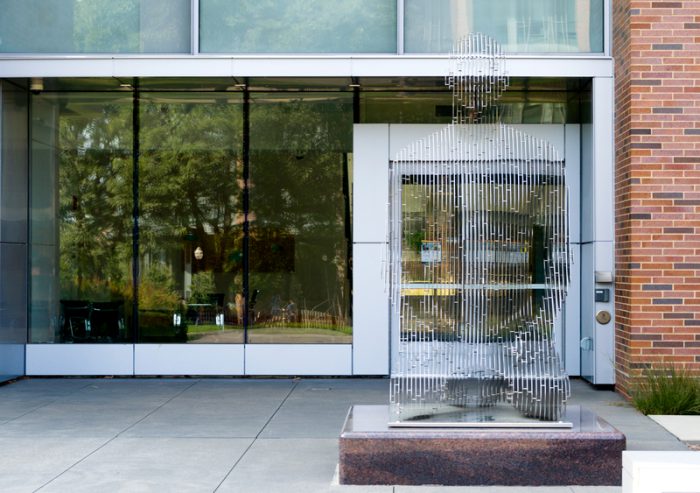Optical illusions are a source of endless fascination. Lines of equal length that appear to be different sizes. Still images that appear to move. Even 3D-movie technology is an optical illusion—using our natural stereoscopic vision as a way to create depth. But these disappearing sculptures by German-born, American artist Julian Voss-Andreae are some of the coolest examples we've seen yet of visual mind games.
Voss-Andreae and his team take thin sheets of metal, laser cut and weld them, then place them together to create a 3D shape. The result is almost like a skeleton—if you placed "skin" on one, it would appear to be human. But it is a very different skeleton to our own. This is thanks to the way that dozens of parallel sheets of metal nearly disappear from a certain angle.
Observe!
You have questions about quantum science?
We don't exactly have answers...
In the video above, you heard Voss-Andreae talk about the motivation for his disappearing sculptures: quantum science. Just what is that? And how did it influence such magical art?
How big a mystery is quantum science? The massive 27 km (16.7 mi.) long Large Hadron Collider in Switzerland is used just to study it! (Getty Embed)
Explaining quantum science is, well, not easy. It is the study of quantum particles, the smallest matter known. So atoms? Sure, but really, it's even smaller than that. Electrons, protons, and neutrons? Yes, but there's even more. There are neutrinos, muons, gluons, positrons ... the world of quantum science is one beyond microscopes, and beyond even understanding. Many of the world's most brilliant minds are left perplexed by the ways in which these ultra-tiny particles behave—sometimes like solid objects, sometimes like waves of pure energy. It's almost like it is magic.
Back to the disappearing sculptures, you can begin to see how this influenced Voss-Andreae. Like quantum science, each sculpture's appearance depends on how you are looking at it. Are they solid objects? Or just impressions in our mind? The mysteries of the universe turned into art!
Mind = blown, right?
 Can you see the kneeling man? An example of Julian Voss-Andreae's mind-blowing work at the University of Minnesota. (Ken Wolter | Dreamstime.com)
Can you see the kneeling man? An example of Julian Voss-Andreae's mind-blowing work at the University of Minnesota. (Ken Wolter | Dreamstime.com)










Woah
It has no part of the skin. The sculptures are fun. I would like to see them in person.
😯
😎